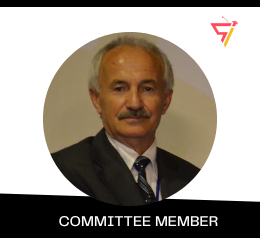Scholars 4th Edition International Conference on
Catalysis and Chemical Engineering
THEME: "Exploring Critical Breakthroughs in Catalysis and Chemical Engineering"
 27-28 Mar 2023
27-28 Mar 2023  Crowne Plaza Ealing, London, UK & Online
Crowne Plaza Ealing, London, UK & Online THEME: "Exploring Critical Breakthroughs in Catalysis and Chemical Engineering"
 27-28 Mar 2023
27-28 Mar 2023  Crowne Plaza Ealing, London, UK & Online
Crowne Plaza Ealing, London, UK & Online 
Firat University, Elazig, Turkey
Title: Shape Reversibility and Structural Reactions in Shape Memory Alloys
Dr. Osman Adiguzel graduated from Department of
Physics,
He published over 80
papers in international and national journals; He joined over 120 conferences
and symposia in international and national level as Plenary Speaker, Keynote Speaker,
Invited speaker, speaker or Poster presenter. He served the program chair or
conference chair/co-chair in some of these activities. In particular, he joined
in last six years (2014 - 2019) over 60 conferences as Speaker, Keynote Speaker
and Conference Co-Chair organized by different companies in different
countries.
Additionally,
he retired at the end of November 2019, and contributed with Keynote/Plenary
Speeches over 120 Virtual/Webinar Conferences, due to the coronavirus outbreak in
three year of his retirement, 2020 and 2022.
Dr.
Adiguzel served his directorate of Graduate School of Natural
and Applied Sciences,
Scientific fields of Dr. Adiguzel: Shape memory effect
and displacive phase transformations in shape memory alloys and other alloys, molecular
dynamics simulations, alloy modeling, electron microscopy, electron
diffraction, x-ray
diffraction and crystallography.
A series of alloy
materials take place in a class of advanced smart materials with the stimulus
response to external effect. Shape memory alloys take place in this class by
exhibiting a peculiar property called shape memory effect, with the chemical
compositions in the ?- phase field in phase diagrams. This phenomenon is
characterized by the recoverability of two certain shapes of material in
reversible way at different conditions. This phenomenon is initiated with
thermomechanical processes on cooling and deformation and performed thermally
in a temperature interval on heating and cooling, with which shape of materials
cycles between original and deformed shapes in reversible way. Therefore, this
behavior is called thermoelasticity. This is plastic deformation; the strain
energy is stored in the material and releases upon heating by recovering the
original shape. This phenomenon is result of structural reactions, thermally
and stress induced martensitic transformations. Thermal induced martensitic
transformation occurs on cooling with cooperative movements of atoms in <110
> -type directions on the {110} - type planes of austenite matric, along
with the lattice twinning reaction, and ordered parent phase structures turn
into the twinned martensite structures. Twinned structures turn into the
detwinned structures by means of stress induced martensitic transformation with
deformation in the martensitic condition.
These alloys exhibit
another property, called superelasticity, which is performed with stressing and
releasing the material in elasticity limit at a constant temperature in parent
phase region, and shape recovery is performed instantly and simultaneously upon
releasing the applied stress, by exhibiting elastic material behavior. Stress-strain profile is nonlinear in
stress-strain diagram, also stressing and releasing paths are different, and
hysteresis loops refers to energy dissipation. Superelasticity is also result
of stress induced martensitic transformation and ordered parent phase structure
turns into the detwinned martensite structure with stressing.
Copper based alloys
exhibit this property in metastable ?-phase region, which has bcc-based
structures at high temperature parent phase field. Lattice invariant shear and twinning is not
uniform in these alloys and gives rise to the formation of complex layered
structures. These structures can be
described by different unit cells as 3R, 9R or 18R depending on the stacking
sequences.
In the present
contribution, x-ray diffraction and transmission electron microscopy (TEM)
studies were carried out on copper based CuAlMn and CuZnAl alloys. X-ray
diffraction profiles and electron diffraction patterns exhibit super lattice
reflections. X-ray diffractograms taken in a long-time interval show that
diffraction angles and peak intensities change with aging duration at room
temperature. This result refers to the
rearrangement of atoms in diffusive manner.
Keywords: Shape memory effect, martensitic transformation,
thermoelasticity, superelasticity, twinning, detwinning.